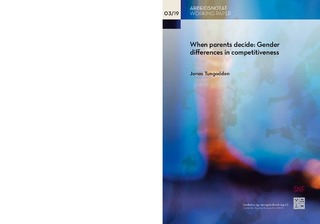When parents decide : gender differences in competitiveness
Working paper

Åpne
Permanent lenke
http://hdl.handle.net/11250/2620203Utgivelsesdato
2019-06Metadata
Vis full innførselSamlinger
- Working papers (SNF) [809]
Sammendrag
The gender difference in willingness to compete has been proposed as an explanation
for the observed gender difference in education and labor market outcomes. This paper
presents the first study of how parents make competitiveness choices for their children.
In an experiment with 1480 parents and adolescent children, parents choose if their child
will do a task for a competitive or non-competitive pay scheme. The paper establishes
a number of novel facts on parents’ choices for children. First, parents choose more
competition for boys than for girls. The gender gap in parents’ choices is smaller than
that in children’s own choices. Second, two main mechanisms explain the gender gap in
parents’ choices: their beliefs about children’s preferences and paternalistic behavior.
Third, parents’ choices are more responsive to the ability of boys than girls, which
results in many high-ability girls not entering into competition. Fourth, parent gender
matters: fathers are more likely than mothers to enter their child into competition.
Finally, children are unaware of the gender difference in parents’ choices and believe
that parents will make the same choices for boys and girls. The set of findings sheds
new light on the role of parents in determining children’s long-term outcomes and on
the intergenerational transmission of preferences.